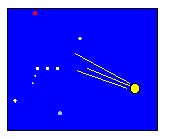 |
Astronomy 101 Problem Set #5 |  |
This Problem Set is due by 1:00 pm on Thursday, 6 October
 |
Astronomy 101 Problem Set #5 |  |
This Problem Set is due by 1:00 pm on Thursday, 6 October
Problem #1: Sunscreen performs a remarkable task for us. The little molecules in sunscreen absorb ultraviolet light which would otherwise impact your skin with the potential to break apart important biological molecules and substantially increase your chances of getting cancer. However, after they absorb the energy from these ultraviolet photons, the sunscreen molecules have to get rid of it. They do this by emitting infrared photons, which because of their much lower energy, are harmless to us. So in a real sense, sunscreen is a "wavelength converter," turning ultraviolet photons into infrared ones.
a) An ultraviolet photon has a wavelength of about 300 nm. Calculate the energy contained in one photon of this wavelength.
b) The molecules in your body are held together with chemical bonds whose typical binding strength is about 6 x 10-19 Joules. Another way to say this is that you can break these chemical bonds with 6 x 10-19 Joules of energy. If those bonds break or your chemistry is altered in some way, the damage to your system can be substantial, and might include creating cancers. Is the energy you found in part a) sufficient to potentially cause damage to your tissue?
c) Let's assume that the sunscreen converts the energy it receives when it absorbs one 300 nm photon into infrared photons with a wavelength of 2100 nm. Calculate the energy contained in one 2100 nm photon and determine if this type of photon is capable of doing damage to your tissue.
d) How many 2100 nm photons would a sunscreen molecule have to emit to get rid of the energy it collected when it absorbed one 300 nm photon?
Problem #2: The filament in a regular incandescent lightbulb reaches a temperature of 2900 K when it's on.
a) Calculate the wavelength at which the blackbody spectrum from this filament is most intense.
b) What type of light (e.g., utraviolet, optical, infrared, radio) is a photon of this wavelength?
c) In light of your answer to part b), explain why incandescent light bulbs are not a very efficient way to produce optical light.
Problem #3: The Space Shuttle travels at a speed of 7700 m/s in orbit around the Earth at an altitude above the Earth's surface of 300 km. From this information, calculate the mass of the Earth.
